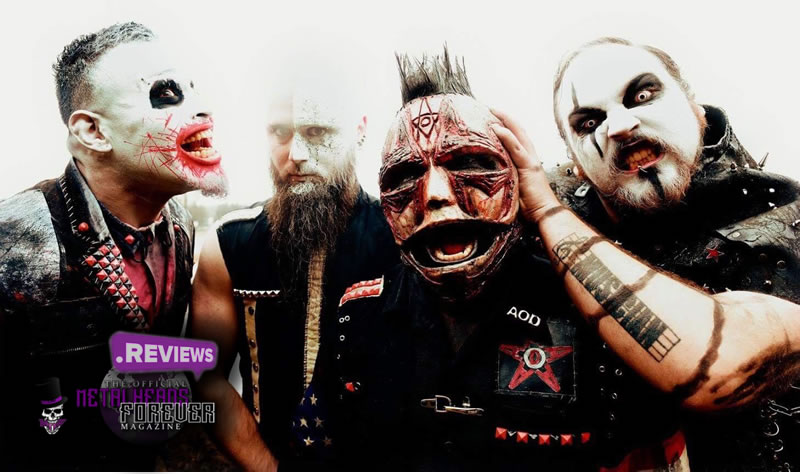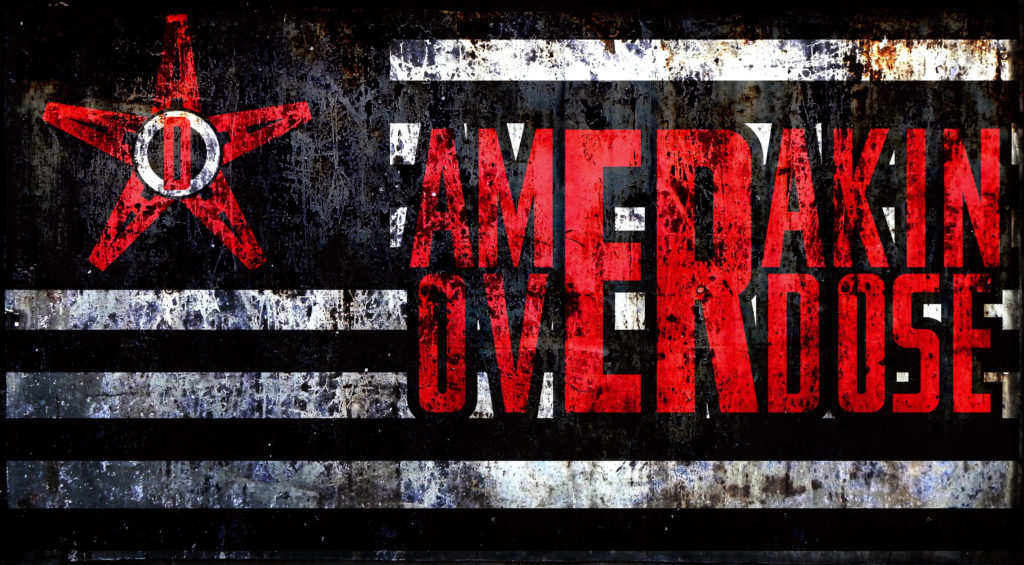“Amerakin Overdose” Marking the Decade by Michael Aronovitz
When I say “Marking the Decade,” I mean “defining it,” but Amerakin Overdose seems to have little interest in broad generalizations that would create pockets and safe-havens other projects might use to cement their own brands. Amerakin Overdose made a distinct mold and then broke it into a million pieces. On purpose. Period. They also created a rather glorious phantom-shadow that is tied to them, at times, like a dark aesthetic twin, at others, a strange pitted doppelganger, but regardless of the lens Amerakin Overdose makes us look at them through, it’s a fabulous hall of mirrors, isn’t it?
To be clear, when I refer to the band’s “phantom-shadow – doppelganger effect,” I am talking about the hype, the window-dressing, and side-bars. And so the most obvious first nod goes to the masks and the face paint, of course it does, and well done. Now, don’t get me wrong. Even though I put this part of the package in with the hype and the window dressing, I don’t think anyone questions the authenticity of the band’s presentation in terms of carrying on the grand tradition of Kiss, Slipknot, and a number of other bands who have used similar costuming. I even go a step further in my admiration of AOD’s particular spin on this, as I made clear in my article a year and a half ago when I made the point that the stage persona of Amerakin Overdose is not just a simplistic allusion (or tribute) to masked bands, Leatherface, Michael Meyers, or Jason Vorhees for that matter, but more a conduit utilized to show the inner rage no one sees…the ID…a toxic pathos exposed.
Second, in terms of AOD’s peripheral fireworks, there is the message that we see in the interview scenarios, through which a given band representative talks about American indulgence and our relative blindness to the addiction in a clear salute to similar past civic criticisms offered to us by great literary masters such as Jonathan Swift, Ben Franklin, Charles Dickens, and F. Scott Fitzgerald.
Third, we have the vivid social media presence of lead singer Cody Perez, creating a character so prolific and transparent (and filled with such rage-filled honesty) it almost surpasses his stage persona on a platform of shock-theater and social warfare. A perfect example of this would be the fiery commentary Perez gave us earlier in the summer concerning Otep, her clear disdain for hometown projects, and her ridiculous claim that warm up bands had some sort of obligation to serve their “betters” by closing their merchandise stands when the headliners took the stage.
All a hall of mirrors. A phantom-shadow. Shakespeare used this particular device by creating multiple tiers of biting commentary, theming, and symbolisms that appealed to the nobles on one level, the merchant class on another, and the peasants in ways that thrilled them. In terms of music, this sort of clever and poetic architecting of social economics is usually translated as an “X” factor, most often an intangible we can’t really quantify except for the idea that it is as simple as “stage presence.” In this case, it has been meticulously developed over time, possibly without the band even planning it in a war-room, and I don’t just find this to be “lucky.” It’s magical, and the only reason we might not recognize the overall significance of this particular project is that in the “here and now” we tend not to consider the things unfolding in real time as historical.
Well, fuck it. I write for Metal Heads Forever Magazine now, I do not take this journalistic position lightly, and I am making the claim right here that Amerakin Overdose is the musical signifier of the decade, similar to Van Halen in the 70’s, The Red Hot Chili Peppers in the 80’s, Metallica in the 80’s and 90’s, and System of a Down in the early 2000’s. And it’s not just the phantom-shadow Amerakin Overdose has unfurling behind them like a cloak in the night, in fact, it is the idea that all of the face paint and theming and Facebook rantings create the most effective foreshadowing and payoff I believe I have seen since Led Zeppelin basically schooled the world in the art of subtle advertising, mystery, and omission.
To digress for a hot minute, good foreshadowing as a literary device only works if the phenomena early in the surface text has rock solid justification for being there. The payoff, is that later in the script, we see the same object or issue in a different light that makes us go “wow!” In this case, whether purposefully or inadvertently, Amerakin Overdose has given us that bonafide foreshadowing: masks and face paint, the symbolic team message, the loud social politics. The reason this is also a doppelganger, is that it draws attention away from the music. The reason why it is perfect foreshadowing, however, is that the “doppelganger,” presented as a foil, becomes the ultimate “Ah-ha!” moment, when we find out that in the end, under all of the layers, the music is mother-fucking magnificent.
Amerakin Overdose’s album The Great Amerakin Dream, (one year anniversary September 30th) features Cody Perez on vocals, Pito Perez on backing vocals, Human on keys and all guitars, Brick on drums, and Brandon Sills on bass. Plainly, this is a landmark album, marking the decade, making history in real time like a broad horizon pouring colors on the world. When you put on the record and turn it up loud, all the fanfare, the theatrics and circus frowns, the pomp and the circumstance, become secondary, as the musicianship is absolutely stellar. Why else would so many fans, neck-wreckers, metal-mags, and rising-star You Tube personalities like “Metal Jim” be giving the band such loving attention? Well, to put it bluntly, Perez can growl like a super-charged buzzsaw or sing in a traditional high baritone that twists your heart. Pito backs him perfectly, from the soul of a true blood brother, and their harmonies have an honesty and gentle flair that make you think of childhood, that smoky tang of burning leaves in autumn, first love, first rebellions. Human, Sills, and Brick are a literal wall of sound in terms of axe, bass, and drums, yet intricate and complex in arrangement, like some exotic wild cheetah in the portrait of a dream state. Then, when we consider Human’s additional influence on keyboards both rhythmically and at times atonally, there is this oxymoronic hard yet sweet disequilibrium that cements the genre-tag I’ve heard so often that pigeon-holes the holistic experience as “Industrial Trance Metal.”
I have never really made a habit of labeling, as it so often seems limiting. Don’t get me wrong…I like the aforementioned tag as much as the next metal-head, but I find The Great Amerakin Dream to be more than representative of “genre,” in fact, I interpret the work as far more than metal.
The Great Amerakin Dream is notably fresh, categorically raw, amazingly frightening, and wonderfully addictive. The album cover of a naked girl and the blood covered mattress behind her is directly linked to the first song titled “Red, White, and Black,” sung by guest female vocalist “Bria.” It is a dark, ironic parody of the National Anthem, accompanied by off-color dialogue about the constitution, weird guitar-stingers reminiscent of the beginning of “Iron Man,” strange cellphone utterances robotified like a kidnapper, and the dystopian, atonal creepiness of the band coming in behind a vocal line (modified off of the original) at the point where she sings, “And the rockets’ red glare.” Farther along, the music drops out as if cut by a knife at O’er the land of the free,” and then we have our quick final silence.
My fucking God. The scariest moments are the ones where situational ironies put things of innocence in a context of evil. It is what Wes Craven did so effectively with A Nightmare on Elm Street (1984) after the first dream sequence and opening credits, where the three elementary school girls in their white party dresses and hair ribbons are playing jump rope and singing slightly off key to the creepy background music: “One, two, Freddy’s coming for you…”
Amerakin Overdose produces a similar effect, yet instead of changing the words, as said, they alter the vocal line and instrumentation, those which corrode the anthem and form an association with the naked cover-model and the blood-soaked mattress behind her. It is almost like she becomes the vocalist, automatically creating both fear and sympathy in the listener instead of disdain for what some might otherwise label rank and gratuitous.
The title track, The Great Amerakin Dream is exceptionally well written, with “blast-notes” in the beginning like gunfire that show off just how fast Brick can work those hummingbird 16ths on his double bass drums. The choral hook is amazingly heart rending, so much so that you don’t even realize they’ve cut the tempo to halves, and Human’s lead guitar solo is the epitome of emotion, full of distorted bends that are patterned like a bursts of terrifying static bristling over the syncopated background like lightening across a relief map. Then, when you thought it couldn’t get any better, they produce the out-tro to blink in and out to another dead silence. Theme layered on theme, with a horror movie undercurrent that keeps the listener riveted.
Musically, the groove of the third track and the heaviness of its funk riff make it seem like “Face Down Ass Up” is a concert must, probably placed somewhere in the middle of the set where the head-banging sprains necks, and the center of the arena becomes the jewel of sweet chaos you’d better start live-streaming or you’ll regret it for life.
“Cyber Superstar” is the smash-hit of this album. I know there are those who would vote “I, Alone” or “C.U.N.T,” but I am going to be the bold minority and vouch for this dark horse as the ultimate hood ornament. First, the song is thematically timeless in reference to groupies, wanna-be rockers, and the tasteless pit they both might fall into…like those who would idolize athletes more for the endorsement deals than the sport that got them there. The song is also relevant on more immediate grounds, as it ties in directly with current trends of over-exposure, and ironically, the disturbing Great Amerakin Dream album cover, portraying the strange female sitting in the foreground of a mattress she menstruated upon, appearing to take a picture (or study the mirror-image) of her own privates. It is as if she has become a hideous, personified evolution of our social media habits, haunting us with a vision of our own self-shaming.
Aside from the emblematic alignments to the album cover however, the song “Cyber Superstar” has everything one could ask for in terms of “hit potential” on a multitude of platforms. The hard rhythmic chops are unmistakable, making the tune an automatic success in the arena or out on the dance floor. The keys back the guitar with a broadband metal fullness I haven’t heard since Deep Purple’s Machine Head (1972), and the vocals are so diverse that there is just as valid a hip hop feel in the second half of the first verse as there is a clear-cut ballad hook in the traditionally sung chorus. I could just as easily picture this song played on WMMR, my city’s biggest commercial rock station, as the University of Pennsylvania’s alternative listener-sponsored WXPN. And Serius Radio? Octane and Liquid Metal. All day. No doubt about it.
I must admit that here just past the 1/3 mark in the record, “I, Alone” stands out as an obvious go-to for a hit single as well. Of course, the band put together a phenomenal video that contains graphic, intensive scene units depicting addiction and domestic violence, as well as blissful recovery and a journey back to childlike innocence. And in terms of pure audio, “I’Alone” rocks with staying power. The machine-gun snare/guitar introduction is classic, and the break from the current standard of growl vocal verses and traditionally sung choruses makes for an effective inversion. The variation of the opening theme turned to a mid-song break with those awesome chock n’ gravel guitar chords is majestic, and one can’t help but think that altogether this is one of the band’s very best works.
The tune in the six-spot titled “Medicate” has a metal-groove that is absolutely killer. The rhythm section is intoxicating, and the carefully placed whispers of Cody Perez remain chilling. The overall feel with this is reverse vertigo, as if the camera is below some sort of glass floor and we are looking up in terror at some massive force steamrolling across our faces, men in thick boots marching, massive dark towers marking the periphery.
The next song “Love Like Ecstasy,” remains Human’s tune through and through, highlighting the importance of the keyboards not only as background and spice, but a main course of weight and of substance. The way he weaves in and out of the groove here not only makes the song, but defines it, cutting the path, telling the story. Of course, everyone else’s performances are superb, but I must say I have never heard a keyboard so closely resemble fucking. Slowly. Achingly. Possessively. The fullness of the production is noticeable as always here, and the harmony vocals are literally sublime. Still, the heart and soul and spine of this thing are constructed through a template of ebony and ivory keys.
Cut number eight is titled “Sober Eyes,” and the song does not disappoint. Here, Brick stands out, commanding a rhythm section laced with dynamic fills, but built on hard core thunk and crash like they did in the 70’s. Like Frankenstein’s lead-heavy boots, Brick pounds out a beat that proves he is confident enough not to have to fill every square inch of space with faster and faster double bass licks, as he works the pauses, kicking deep, making thunder. And while no one would dare claim Cody Perez ever traded authenticity for a marketing tool, it is easy for all of us to admit that his “Swing batter swing” is a hook that sticks as hard as “You really got me” or “Come on baby, light my fire.”
The ninth song is the infamous “C.U.N.T,” which I wrote an article about a year and a half ago for my private column “Goblet of Shock.” In the spirit of never wanting to repeat myself, I will simply say this here and now. “C.U.N.T” is an outstanding symbol of the raw, battered soul. It is portrayed here as a face turned inside-out in the form of Perez’s mask, showing the rage we hide underneath and all the malignant hidden demons boiling up to the surface. Musically, the tune has the groove and swag of any mega-hit I can think of, ‘nuff said.
Cut number ten, “Nothing Remains,” is an epic reminder that our indulgences are self-induced, “Man made man made,” and the tune itself is rhythmically massive, filled with off-beat chops, incredible crunch, and a swing vibe made almost hypnotic with the traditional vocal. Juxtaposed to this are some mega-fills Brick is so good at inserting in the form of lightening or lace depending on the phrase and context he chooses to create, and the intertwined growl vocal gives us the anger and credibility we look for, first track to last.
The last songs on The Great Amerakin Dream seem to go together in trilogy.
In terms of the lyrics in “Letting Go” we see the phrases, “We’ve cut the past, inhaled the lines” and “Now all that’s left in the dust has cleared/An empty soul and countless fears,” voicing the continued theme here of self-devastation, and in “Revolution” we hear, “Diseased, infected with your bitter taste…Tonight I’ll make you mine…resentful of your wicked ways/We won’t forgive, we won’t forget,” and we can feel ourselves evolve as listeners, starting to take responsibility for our own self-awareness. And with “Gone Away” and its tender pleas, “I bid farewell/A part of me has died/With You tonight…You’ve left us for a better place,” it becomes clear that maybe we have journeyed to a place where we can admit that seeing the light comes with sacrifice.
In reference to the music itself, “Letting Go” is mesmerizing with a rich vocal, some screams, and the signature hard, dreamy rhythms. “Revolution” is the prior song’s antithesis, fast and driving, with an alarm siren, atonal note-bends, growls that sound like they hurt, and power-chord funk chops turbo-charged with Cody Perez’s screams of “Enough is enough!” And with the ballad “Gone Away” we get a powerful demonstration of Cody Perez’s range and diversity. His innocent traditional vocal, soon embellished with octave work and brought to crescendo with masterful execution in a climactic higher range, makes for the ideal coda, accompanied by Human on acoustic piano.
Amerakin Overdose is iconic. They hack new wood while embracing tradition, playing for us on so many levels and from such diverse strike-points, it might be difficult to see the forest for the trees. And while the record is musically innovative and startlingly fresh, I would insist one last time that it is also an archetypal, in that the band left open thousands of ways we could connect to The Great Amerakin Dream, some we haven’t even thought of quite yet. Maybe that’s for the next generation, and the ones that will follow. After all, is not the very definition of a classic, the idea that the work somehow stays forever relevant, always acting as the springboard for new stories and life-portraits?
Musically, Amerakin Overdose is brilliant.
Historically, they are absolutely quintessential.
Michael Aronovitz is a horror author who has published three novels, two collections, more than thirty short stories, and a number of horror and metal reviews. His first novel “Alice Walks” will come out in E-book form through Cemetery Dance Publications this fall. His latest novel “Phantom Effect” can be seen on Amazon here: http://tinyurl.com/jcg59wo
Michael Aronovitz / MHF Magazine






